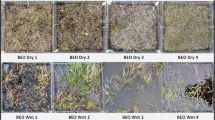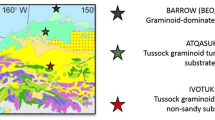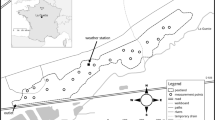Abstract
The aim of this study was to establish the main drivers of the spatial variability in growing season CH4 flux within an arctic wetland ecosystem. During 3 years (2011–2013) we measured CH4 flux and potential drivers, e.g., CO2 fluxes (net ecosystem exchange (NEE), gross primary productivity (GPP) and ecosystem respiration), temperature, water table depth, pore-water concentration of organic acids (e.g., acetate) and the vascular plant composition and density. The study included 16–20 main plots (Cmain) and in 2013 also experimental plots (10 excluded muskoxen grazing, 9 snow fence and 10 automated chamber plots) distributed over 0.3 km2. The results show a 1.8-times difference in CH4 flux magnitude inter-annually and 9- to 35-times spatially (depending on year and treatment). During all 3 years GPP was a strong driver of the variability in Cmain plots. Accordingly, the plant productivity related variables NEE, GPP and acetate were singled out as the strongest drivers of the variability in 2013, when all variables were measured on a majority of the plots. These variables were equally strong drivers of the spatial variability in CH4 flux regardless of whether experimental plots were included in the analysis or not. The density of Eriophorum scheuchzeri was the strongest driver of the spatial variability in NEE, GPP and acetate. In conclusion, changes in vegetation composition or productivity of wet arctic ecosystems will have large impacts on their carbon balance and CH4 flux, irrespective of whether these changes are driven directly by climate change or by biotic interactions, such as grazing.




Similar content being viewed by others
References
Arndal M, Illeris L, Michelsen A, Albert K, Tamstorf M, Hansen B (2009) Seasonal variation in gross ecosystem production, plant biomass, and carbon and nitrogen pools in five high arctic vegetation types. Arct Antarct Alp Res 41:164–173. doi:10.1657/1938-4246-41.2.164
Bay C (1997) Floristic division and vegetation zonation of Greenland of relevance to a circumpolar arctic vegetation map. In: Proceedings of the second circumpolar arctic vegetation mapping workshop, Arendal, Norway, 19–25 May 1996, Occasional paper No. 52, Institute of Arctic and Alpine Research, University of Colorado, pp 27–31
Bellisario LM, Bubier JL, Moore TR, Chanton JP (1999) Controls on CH4 emissions from a northern peatland. Glob Biogeochem Cycles 13:81–91
Bubier JL (1995) The relationship of vegetation to methane emission and hyrdochemical gradients in northern peatlands. J Ecol 83:403–420
Chanton JP, Bauer JE, Glaser PA, Siegel DI, Kelley CA, Tyler SC, Romanowicz EH, Lazrus A (1995) Radiocarbon evidence for the substrates supporting methane formation within northern Minnesota peatlands. Geochim Cosmochim Acta 59:3663–3668
Chasar LS, Chanton JP, Glaser PH, Siegel DI, Rivers JS (2000) Radiocarbon and stable carbon isotopic evidence for transport and transformation of dissolved organic carbon, dissolved inorganic carbon, and CH4 in a northern Minnesota peatland. Glob Biogeochem Cycles 14:1095–1108
Christensen TR, Friborg T, Sommerkorn M, Kaplan J, Illeris L, Soegaard H, Nordstroem C, Jonasson S (2000) Trace gas exchange in a high arctic valley 1: variations in CO2 and CH4 flux between tundra vegetation types. Glob Biogeochem Cycles 14:701–713
Christiansen HH, Sigsgaard C, Humlum O, Rasch M, Hansen BU (2008) Permafrost and periglacial geomorphology at Zackenberg. Adv Ecol Res. doi:10.1016/S0065-2504(07)00007-4
Crill PM, Bartlett KB, Harriss RC, Gorham E, Verry ES, Sebacher DI, Madzer L, Sanner W (1988) Methane flux from Minnesota peatlands. Glob Biogeochem Cycles 2:371–384
Dise NB, Gorham E, Verry ES (1993) Environmental factors controlling CH4 emissions from peatlands in northern Minnesota. J Geophys Res 98:583–594
Elberling B, Nordstrøm C, Grøndahl L, Søgaard H, Friborg T, Christensen TR, Ström L, Marchand F, Nijs I (2008) Higharctic soil CO2 and CH4 production controlled by temperature, water, freezing and snow. Adv Ecol Res 40:441–472 (Elsevier Academic Press Inc, San Diego)
Falk JM, Schmidt NM, Ström L (2014) Effects of simulated increased grazing on carbon allocation patterns in a high arctic mire. Biogeochemistry 119:1–16
Glaser PH, Chanton JP (2009) Methane accumulation and release from deep peat: measurements, conceptual models, and biogeochemical significance. Geophys Monogr Ser 184:145–158
Goulden ML, Crill PM (1997) Automated measurements of CO2 exchange at the moss surface of a black spruce forest. Tree Physiol 17:537–542
Greenup A, Bradford LM, McNamara AN, Ineson PP, Lee JA (2000) The role of Eriophorum vaginatum in CH4 flux from an ombrotrophic peatland. Plant Soil 227:265–272
Gupta M (2012) Cavity-enhanced laser absorption spectrometry for industrial applications. Gases Instrum 6:23–28
Hansen BU, Sigsgaard C, Rasmussen L, Cappelen J, Hinkler J, Mernild SH, Petersen D, Tamstorf MP, Rasch M, Hasholt B (2008) Present-day climate at Zackenberg. Adv Ecol Res 40:111–149 (Elsevier Academic Press Inc, San Diego)
Hansen LH, Hansen J, Christoffersen KS, Lund M, Nielsen PS, Christensen MU, Schmidt NM (2013). The BioBasis programme. In: Jensen LM, Rasch M, Schmidt NM (ed) 2013. Zackenberg Ecological Research Operations, 18th Annual Report, 2012. Aarhus University, DCE—Danish Centre for Environment and Energy, p 122
Henry GR (1998) Environmental influences on the structure of sedge meadows in the Canadian High Arctic. Plant Ecol 134:119–129
Jackson RB, Caldwell MM (1992) Shading and the capture of localized soil nutrients: nutrient contents, carbohydrates, and root uptake kinetics of a perennial tussock grass. Oecologia 91:457–462
Joabsson A, Christensen TR (2001) Methane emissions from wetlands and their relationship with vascular plants: an Arctic example. Glob Chang Biol 7:919–932
Joabsson A, Christensen TR, Wallén B (1999a) Vascular plan controls on methane emissions from northern peatforming wetlands. Trends Ecol Evol 14:385–388
Joabsson A, Christensen TR, Wallén B (1999b) Influence of vascular plant photosynthetic rate on CH4 emission from peat monoliths from southern boreal Sweden. Polar Res 18:215–220
Kirschke S, Bousquet P, Ciais P, Saunois M, Canadell JG, Dlugokencky EJ, Bergamaschi P, Bergmann D, Blake, Bruhwiler L, Cameron-Smith P, Castaldi S, Chevallier F, Feng L, Fraser A, Heimann M, Hodson EL, Houweling S, Josse B, Fraser PJ, Krummel PB, Lamarque J-F, Langenfelds RL, Le Quéré C, Naik V, O’doherty S, Palmer PI, Pison I, Plummer D, Poulter B, Prinn RG, Rigby M, Ringeval B, Santini M, Schmidt M, Shindell DT, Simpson IJ, Spahni R, Steele LP, Strode SA, Sudo K, Szopa S, Van Der Werf GR, Voulgarakis A, Van Weele M, Weiss RF, Williams JE, Zeng G (2013) Three decades of global methane sources and sinks. Nat Geosci 6:813–823. doi:10.1038/NGEO1955
Kristensen DK, Kristensen E, Forchhammer MC, Michelsen A, Schmidt NM (2011) Arctic herbivore diet can be inferred from stable carbon and nitrogen isotopes in C3 plants, faeces, and wool. Can J Zool 89:892–899
Kuzyakov Y, Domanski G (2000) Carbon input by plants into the soil. Review. J Plant Nutr Soil Sci 163:421–431
Lai DYF, Roulet NT, Tim R, Moore TR (2014) The spatial and temporal relationships between CO2 and CH4 exchange in a temperate ombrotrophic bog. Atmos Environ 89:249–259. doi:10.1016/j.atmosenv.2014.02.034
Mastepanov M, Sigsgaard C, Dlugokencky EJ, Houweling S, Ström L, Tamstorf MP, Christensen TR (2008) Large tundra methane burst during onset of freezing. Nature 456:628–631
Mastepanov M, Sigsgaard C, Tagesson T, Ström L, Tamstorf MP, Lund M, Christensen TR (2013) Revisiting factors controlling methane emissions from high-Arctic tundra. Biogeosciences 10:5139–5158
McGuire AD, Anderson LG, Christensen TR, Dallimore S, Guo L, Hayes DJ, Heimann M, Lorenson TD, Macdonald RW, Roulet N (2009) Sensitivity of the carbon cycle in the Arctic to climate change. Ecol Monogr 79:523–555. doi:10.1890/08-2025.1
McGuire AD, Christensen TR, Hayes D, Heroult A, Euskirchen E, Kimball JS, Koven C, Lafleur P, Miller PA, Oechel W, Peylin P, Williams M, Yi Y (2012) An assessment of the carbon balance of Arctic tundra: comparisons among observations, process models, and atmospheric inversions. Biogeosciences 9:3185–3204
Petrescu AMR, Van Beek LPH, Van Huissteden J, Prigent C, Sachs T, Corradi CAR, Parmentier FJW, Dolman AJ (2010) Modeling regional to global CH4 emissions of boreal and arctic wetlands. Glob Biogeochem Cycles 24:GB4009. doi:10.1029/2009GB003610
Ping CL, Michaelson GJ, Jorgenson MT, Kimble JM, Epstein H, Romanovsky VE, Walker DA (2008) High stocks of soil organic carbon in the North American Arctic region. Nat Geosci 1:615–619. doi:10.1038/ngeo284
Post WM, Emanuel WR, Zinke PJ, Stangenberger AG (1982) Soil carbon pools and world life zones. Nature 298:156–159
Rogerson PA (2001) Statistical methods for geography. Sage Publications Ltd, Cromwell Press Ltd, London, pp 124–153
Ström L, Christensen TR (2007) Below ground carbon turnover and greenhouse gas exchanges in a sub-arctic wetland. Soil Biol Biochem 39:1689–1698
Ström L, Ekberg A, Mastepanov M, Christensen TR (2003) The effect of vascular plants on carbon turnover and methane emissions from a tundra wetland. Glob Chang Biol 9:1185–1192
Ström L, Mastepanov M, Christensen TR (2005) Species-specific effects of vascular plants on carbon turnover and methane emissions from wetlands. Biogeochemistry 75:65–82
Ström L, Tagesson T, Mastepanov M, Christensen TR (2012) Presence of Eriophorum scheuchzeri enhances substrate availability and methane emission in an Arctic wetland. Soil Biol Biochem 45:61–70
Tagesson T, Mastepanov M, Mölder M, Tamstorf MP, Eklundh L, Smith B, Sigsgaard C, Lund M, Ekberg A, Falk JM, Friborg T, Christensen TR, Ström L (2013) Modelling of growing season methane fluxes in a high-Arctic wet tundra ecosystem 1997–2010 using in situ and high-resolution satellite data. Tellus B 65:1–21
Tang J, Miller PA, Persson A, Olefeldt D, Pilesjö P, Heliasz M, Jackowicz-Korczynski M, Yang Z, Smith B, Callaghan TV, Christensen TR (2015) Carbon budget estimation of a subarctic catchment using a dynamic ecosystem model at high spatial resolution. Biogeosci Discuss 12:933–980
Tarnocai C, Canadell JG, Schuur EAG, Kuhry P, Mazhitova G, Zimov S (2009) Soil organic carbon pools in the northern circumpolar permafrost region. Glob Biogeochem Cycles 23:GB2023. doi:10.1029/2008gb003327
Thomas KL, Benstead J, Davies KL, Lloyd D (1996) Role of wetland plants in the diurnal controls of CH4 and CO2 fluxes in peat. Soil Biol Biochem 28:17–23
Torn MS, Chapin FS (1993) Environmental and biotic controls over methane flux from arctic tundra. Chemosphere 26:357–368
Van Veen A, Merckx R, Van De Geijn SC (1989) Plant- and soil related controls of the flow of carbon from roots through the soil microbial biomass. Plant Soil 115:179–188
Waddington JM, Roulet NT, Swanson RV (1996) Water table control of CH4 emission enhancement by vascular plants in boreal peatlands. J Geophys Res 101:775–785
Wania R, Ross I, Prentice IC (2010) Implementation and evaluation of a new methane model within a dynamic global vegetation model: LPJ-WHyMe v1.3.1. Geosci Model Dev 3:565–584
Whiting GJ, Chanton JP (1992) Plant-dependent CH4 emission in a subarctic Canadian fen. Glob Biogeochem Cycles 6:225–231
Whiting GJ, Chanton JP (1993) Primary production control of methane emission from wetlands. Nature 364:794–795
Zhu RB, Ma DW, Xu H (2014) Summertime N2O, CH4 and CO2 exchanges from a tundra marsh and an upland tundra in maritime Antarctica. Atmos Environ 83:269–281. doi:10.1016/j.atmosenv.2013.11.017
Acknowledgments
This study was carried out as part of the strategic research program: Biodiversity and Ecosystem services in a Changing Climate (BECC), Lund University and the Lund University Center for Studies of Carbon Cycle and Climate Interactions (LUCCI). The research was financed by BECC and INTERACT (International Network for Terrestrial Research and Monitoring in the Arctic). We are also grateful to Aarhus University, Denmark and personnel at Zackenberg field station for logistical support, GeoBasis-Zackenberg monitoring program for running the automated chamber system, Caroline Jonsson for field and laboratory assistance in 2012 and Ulrika Belsing for field assistance in 2013.
Author information
Authors and Affiliations
Corresponding author
Additional information
Responsible Editor: Jack Brookshire.
Rights and permissions
About this article
Cite this article
Ström, L., Falk, J.M., Skov, K. et al. Controls of spatial and temporal variability in CH4 flux in a high arctic fen over three years. Biogeochemistry 125, 21–35 (2015). https://doi.org/10.1007/s10533-015-0109-0
Received:
Accepted:
Published:
Issue Date:
DOI: https://doi.org/10.1007/s10533-015-0109-0




